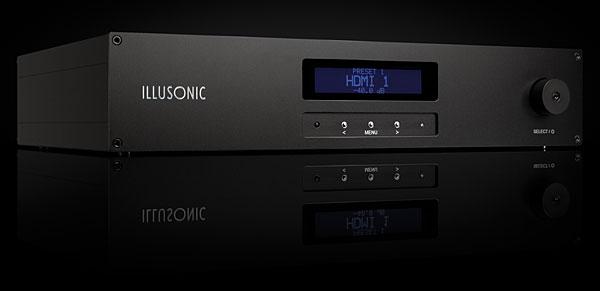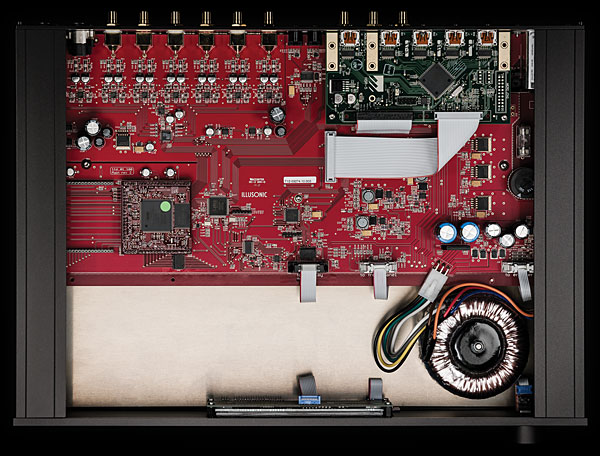| Columns Retired Columns & Blogs |
Music in the Round #64

In my November 2013 column, I looked at the NuForce AVP-18 multichannel preamplifier-processor ($1095) and the exaSound e28 multichannel DAC ($3299), each of which offers fresh options in its category that break with the predictability of mainstream products. That predictability is the result of market analysis that supposedly tells manufacturers which features users want most. However, it's just as true that users can buy and choose among only those components and features already offered. Many of us are more peculiar in our demands—what's generally offered doesn't always fit our needs. This month, I look at an unusual pre-pro and a multichannel digital equalizer at opposite ends of the price spectrum.
Illusonic Immersive Audio Processor
Beginning with its mouthful of a name, the Illusonic Immersive Audio Processor, from Switzerland, is a high-end preamplifier-processor whose developers have a unique idea of what such a device should do: First, at a price of 19,200 Swiss francs, or about $21,300, it should be well constructed, with sound quality and transparency that are beyond significant criticism. Second, it should eschew features made redundant by their inclusion in other system components. Third, it must include features that are either missing from or incompletely implemented in competitive products. (Illusonic has no US distributor; the IAP is available directly from the manufacturer.)
When I first learned of the IAP, I dismissed it because it lacks features, such as dts-HD and Dolby TrueHD decoding, that these days seem de rigueur. In fact, the IAP accepts only PCM or analog signals—it can't even decode plain-vanilla Dolby Digital. The manual states "Up to 8-channel/192kHz/24 bit audio over HDMI is supported. Most Blu-ray players will decode Dolby Digital, Dolby True HD, DTS, and DTS HD and deliver the decoded multi-channel signal to the Immersive Audio Processor." And, indeed, most Blu-ray and universal players will.
On the other hand, the IAP has features that most pre-pros don't. The inclusion of a five-band parametric equalizer in each of its 16 output channels is rare and welcome. Truly unusual is the IAP's ability to process, via those 16 output channels, two- and multichannel sources into one of 168 loudspeaker setups with the ability to manipulate the presentation's spatial distribution using three parameters: Center, Depth/3D, and Immersion. Yes, my Meridian Reference 861 v8 pre-pro will do something similar, but with fewer channels, and not as easily as is possible with the IAP's real-time utilities for Windows and Mac computers. Finally, Illusonic touts the Swiss-made IAP as delivering "high-quality sound, otherwise only found in 2-channel high-end audio equipment," without including unnecessary parts and features. All of this made the IAP increasingly enticing to me. I asked for a review sample.
The IAP's front panel is disarmingly simple. To the right is the volume-control knob, which can be pushed to select among other options reached by using the navigation buttons (Back, Menu, Forward), which sit just below the eminently clear, three-line, alphanumeric display. A small Apple remote duplicates these controls, and a standby LED and an IR receiver complete the panel. While these controls work reliably and exactly as described in the owner's manual, the nesting of menus and the range of controls demand tightly focused attention lest one lose one's place. Illusonic comes to the rescue with a superb control app that, via a USB connection to a computer, gives the user a nice graphic interface to all of the IAP's functions. This is in lieu of a Web-based control app, and avoids the unpredictable response latencies of such apps. The IAP's app works in real time—you can immediately hear the effects of your manipulations.

A look at the rear panel suggests the range of the IAP's processing. There are four HDMI inputs and one HDMI output, three coax and two optical digital inputs, three analog stereo RCA inputs (configurable into a 5.1- or7.1-channel input), and an XLR analog stereo input. Across the bottom of the panel are 16 (count 'em) 16 XLR output connectors labeled, from left to right: SUB, RRCH/FRWH, RLCH/FLWH, RRH, RLH, FRH, FLH, FRW, FLW, RRC/RCH, RLC/RC, RR, RL, FC, FR, and FL.
The XLRs whose labels include slashes can provide different outputs depending on the IAP's setup, but overall, the 16 outputs permit the common arrangements or 2, 3, 4, 5, 7, or 9 channels, with options for subwoofer, height and top (ceiling) speakers, up to a full 9.1+4H+T or 9.1+6H array. With all of these options plus bass management, channel trims, and EQ, it is appropriate that the IAP can store three (soon to be five) preset configurations, as well as Bypass.
With such a range of options, it's likely that every user will seek a different path through them, and unlikely that any will try every possible option. I was limited to 2.1-, 3.1-, and 5.1-channel arrays, supplemented by another pair of channels used as FLH/FRH (front height) or FLWH/FRWH (front width/height) , or a 6.1 setup with a single RC (rear center). Also, had this been a permanent installation, I would have tried harder to optimize very useful bass management. In the interests of time and sanity, I reverted to full-range operation for all main channels. I also used the IAP's parametric EQ for room correction, supported by RoomEQ Wizard (REW) and OmniMic as measurement and filter synthesis tools.
First, I found the straight-through sound quality of the IAP remarkably clean, transparent, and balanced, which qualified it as competitive in its exalted price class. With stereo or multichannel signals, the clarity and soundstaging were open and reminiscent of a good analog preamp, though I still detected a bit of blurring of detail with SACDs and 24-bit/192kHz PCM, as compared to running the analog output of the SACD player through my Audio Research MP1 multichannel preamp. Although the "hardware is principally designed to be able to operate up to 192kHz," per Illusonic, and the IAP can accept signals up to 192kHz via HDMI and 96kHz via S/PDIF, the IAP's internal signal path is 24/48. Nonetheless, I did not find this a limitation except on paper, and would not have suspected the signal path was limited to a 48kHz sample rate had I not been told.
My experiments with adding height and/or width channels were thrilling—the IAP's use of DSP to derive the additional channels and the dependent modification of the main channels was judicious in expanding the soundstage without bloat or loss of spatial resolution. The implementation of the IAP's Center, Depth/3D, and Immersion controls was essential to avoiding those common foibles. For example, the IAP removes front center (phantom center) signals from the FR/FL when a center speaker is present, but the Center control let me optimize the degree of transformation. I could sit at the primary listening position, laptop on lap, and listen while tweaking the processor to my preference, all in real time.
I particularly enjoyed the effect of adding the width and height channels with choral recordings: they expanded the array of voices without losing image specificity. The front high and front wide channels were less effective in my room with FR/C/FL speakers on the short wall, but the addition of a rear center channel really nailed discrete and ambient sounds behind me, and eliminated any ambiguity in those rare source signals that include discrete center-rear information. That said, I have yet to be sufficiently won over by these enhancements (and they really are enhancements) to want to permanently reconfigure my music-only room/system.
Finally, when used with a calibrating microphone (not provided), the IAP can automatically measure and correct speaker levels and distances from the listening seat. I didn't try this because: 1) I already knew those values, and could just plug them into the IAP's set-up; and 2) I was already committed to using RoomEQ Wizard or OmniMic for EQ measurements, which can also provide/confirm these values. Both of those systems are fundamentally mono, but the IAP's ability, in measurement mode, to route the FL input to any output channel made multichannel measurement operations a piece of cake. Run the sweeps, average as needed, calculate and tweak filters, and then enter into the IAP the frequency, gain, and Q values. Further tweaking always seems necessary, and the IAP made it easy to reach a satisfying result by using real-time monitoring and A/B comparisons of multiple presets.
Illusonic's Immersive Audio Processor is not like other processors. Its unique feature set will appeal to sophisticated users who know exactly what they want from their systems: the ability to implement flexible and complex speaker arrangements, a graphic user interface with real-time configuration operations, an effective parametric equalizer, and outstanding overall sound quality. The quality of support has been excellent, with two flawless firmware upgrades during the brief time I've had the IAP; promised enhancements include support for two independent subwoofers, expanded preset functions, virtual channel remapping, and Mac/Windows software for EQ measurements and settings. All of this should appeal to the hands-on audiophile, but only if he or she is willing to forgo high-definition codecs, multiple remote zones, and other bells and whistles commonly found in AVRs. If that's you, the IAP is the way to go.
miniDSP 10x10Hd Digital Signal Processor
For some years, miniDSP Ltd., based in Hong Kong, has provided techie audiophiles with interesting digital-signal-processing (DSP) modules and input/output devices to support audio applications. Their initial products were configured as crossovers, subwoofer interfaces, and equalizers, and were accompanied by analog, S/PDIF, I2S, and USB interfaces. However, based as they are on DSP, as the company's name implies, these devices are fundamentally multipurpose, their applications determined by the chosen interfaces and firmware, which miniDSP calls plug-ins.

These products have fascinated me, stirring up long-buried DIY urges from my past. Think of the DSP capabilities incorporated into all modern audio products—if made discrete, as in miniDSP's components, they could be under your direct control. Megalomania aside, I felt compelled to see whether such things could be used by a nominally normal audiophile who has long forgotten machine code, high-level programming languages, and all things related to programming.
- Log in or register to post comments




































